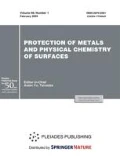Abstract
The low-temperature passivation of the oxide growth on iron is studied with the use of digital ellipsometry at a temperature of 300°C and an oxygen pressure from 10–3 to 1 mmHg. The maximum increment in the oxide thickness as a function of the oxygen pressure P a–p is observed in an hour of exposure, which indicates the active–passive transition. This passivity of iron and other metals can be caused by the multilayer and multiphase structure of the oxide film formed. As the oxygen pressure is increased, an external protective hematite layer appears on iron, and the inner quickly growing magnetite layer has no time to reach its limiting thickness. Shortening of the period of a rapid growth of magnetite, which is observed upon the increase in the oxygen pressure at the same exposure, results in the maximum of the summary thickness of the layer at a certain pressure P a–p. Hematite over the magnetite layer is usually formed as laterally spreading islets, the coalescence of which sharply decelerates the oxidation. In the time–pressure–oxide thickness plot, the areas of the low-temperature passivation of iron can be distinguished in wide ranges of temperature and pressure. The electrophysical treatment in the range of the active–passive transition sharply intensifies the oxidation of iron-based alloys and leads to the formation of layers with a substantial thickness and protective ability.
Similar content being viewed by others
REFERENCES
Kubaschewski, O. and Hopkins, B., Oxidation of Metals and Alloys, London: Butterworths, 1962.
Kofstad, P., Nonstoichiometry, Diffusion and Electrical Conductivity in Binary Metal Oxides, New York: Wiley, 1972.
Hauffe, K., Reactionen in und an Festen Stoffen (Reactions in and on Solids), Berlin: Springer, 1955.
Oxydation des Metaux (Oxidation of Metals), Benard, J., Ed., Paris: Cauthier-Villars, 1964.
Lustman, B. and Mehl, R., Trans. AIME, 1941, vol. 143, p. 246.
Hussey, R.J., Mitchell, D.F., and Graham, M.J., Werkst. Korros., 1987, vol. 38, no. 10, p. 575.
Kotenev, V.A., Zashch. Met., 1998, vol. 34, no. 6, p. 592.
Kotenev, V.A., Zimina, T.Yu., Andreeva, N.P., and Zimin, P.A., Fizika Khimiya Obrab. Met., 1999, no. 4, p. 45.
Zhuk, N.P., Kurs teorii korrozii i zashchity metallov (Theoretical Course of Corrosion and Metal Protection), Moscow: Metallurgiya, 1976.
Turkdogan, E.F., Griweson, P., and Darken, L., J. Phys. Chem., 1963, vol. 67, p. 1647.
Wagner, K., Corros. Sci., 1965, vol. 5, no. 11, p. 751.
Kaesche, H., Die Korrosion der Metalle (Corrosion of Metals), Berlin: Springer, 1979.
Mrowec, S. and Werber, T., Nowoczesne materialy zaroodporne (Modern Heat-Resistant Materials), Warszawa: Wydamnictwa Naukowo-Techniczne, 1982.
Fehlner, F.P., Low-Temperature Oxidation. The Role of Vitreous Oxides, New York: Wiley, 1986.
Hoar, T.R. and Price, L.E., Trans. Faraday Soc., 1938, vol. 34, p. 867.
Jost, W., Diffusion in Solids, Liquids, and Gases, New York: Academic Press, 1952.
Hussey, R.J. and Cohen, M., Corros. Sci., 1971, vol. 11, no. 10, p. 699.
Hussey, R.J. and Cohen, M., Corros. Sci., 1971, vol. 11, no. 10, p. 713.
Arkharov, V.I., Okislenie metallov (Oxidation of Metals), Moscow: Metallurgizdat, 1945.
Schwenk, W. and Rahmel, A., Oxid. Met., 1986, vol. 25, nos. 5-6, p. 293.
Khimushin, F.F., Nerzhaveyushchie stali (Stainless Steels), Moscow: Metallurgiya, 1967.
Evans, U.R., The Corrosion and Oxidation of Metals: Scientific Principles and Practical Applications, London: Edward Arnold, 1960.
Boggs, W.E., Kachik, R.H., and Pellissier, G.E., J. Electrochem. Soc., 1965, vol. 112, no. 6, p. 539.
Graham, M.J. and Cohen, M., J. Electrochem. Soc., 1969, vol. 116, no. 10, p. 1430.
Jensen, C.P., Mitchell, D.F., and Graham, M.J., Corros. Sci., 1982, vol. 22, no. 12, p. 1125.
Kotenev, V.A., Cand. Sci. (Chem.) Dissertation, Moscow: IFKh AN SSSR, 1987.
Kotenev, V.A., Zashch. Met., 1998, vol. 34, no. 6, p. 592.
Kotenev, V.A., Proc. 189th Meeting of the Electrochemical Society, Los Angeles, California: The Electrochem. Soc. Inc., 1996, vol. 96-1, p. 117.
Oxydation des Metaux (Oxidation of Metals), Benard, J., Ed., Paris: Cauthier-Villars, 1962, vol. 1.
Azzam, R.M.A. and Bashara, N.M., Ellipsometry and Polarized Light, Amsterdam: North-Holland Publishing Co., 1977.
Kotenev, V.A., Zashch. Met., 2003, vol. 39, no. 3, p. 260.
Archer, R.J., Ellipsometry, Chicago: Gaertner Scientific Corp., 1968.
Kotenev, V.A., Doctoral (Chem.) Dissertation, Moscow: IFKh RAN, 1998.
Osnovy ellipsometrii (Basics of Ellipsometry), Rzhanov, A.V., Ed., Novosibirsk: Nauka, Sib. Otdel., 1979.
Tanaka, T., Jap. J. Appl. Phys., 1979, vol. 18, no. 6, p. 1043.
Max, J., Methodes et techniques de traitement du signal et applications aux mesures physiques (Methods and Techniques of Treating Signals and Applications to Physical Measurements), Paris: Masson, 1981.
Kubaschewski, O., Iron Binary Phase Diagrams, Berlin: Springer, 1982.
Birks, N. and Meier, G.H., Introduction to High Temperature Oxidation of Metals, Pittsburgh: Edward Arnold, 1983.
Howe, C.I., McEnaney, B., and Scott, V.D., Corros. Sci., 1985, vol. 25, no. 3, p. 195.
Belen'kii, V.Z., Geometriko-veroyatnostnye modeli kristallizatsii. Fenomenologicheskii podkhod (Geometrical-Probabilistic Crystallization Models. Phenomenological Approach), Moscow: Nauka, 1980.
Kofstad, P., High Temperature Oxidation of Metals, New York: Wiley, 1966.
Author information
Authors and Affiliations
Rights and permissions
About this article
Cite this article
Kotenev, V.A. To the Low-Temperature Passivity of Iron at the Gaseous Oxidation. Protection of Metals 39, 301–310 (2003). https://doi.org/10.1023/A:1024926927108
Issue Date:
DOI: https://doi.org/10.1023/A:1024926927108


